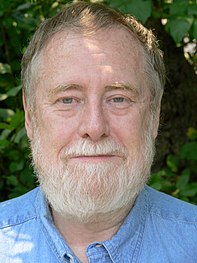Scott Fahlman
Scott Fahlman | |
|---|---|
 Photo of Scott Elliott Fahlman | |
| Born | Scott Elliott Fahlman March 21, 1948 |
| Citizenship | American |
| Alma mater | Massachusetts Institute of Technology |
| Scientific career | |
| Fields | Natural language processing, Computer Science |
| Institutions | Carnegie Mellon University |
| Thesis | NETL: A System for Representing and Using Real-World Knowledge (1977) |
| Doctoral advisor | Gerald Jay Sussman |
| Doctoral students | David S. Touretzky Michael Witbrock |
Scott Elliott Fahlman (born March 21, 1948) is a computer scientist at Carnegie Mellon University. He is notable for early work on automated planning in a blocks world, on semantic networks, on neural networks (and, in particular, the cascade correlation algorithm), on the Dylan programming language, and on Common Lisp (in particular CMU Common Lisp and he was one of the founders of Lucid Inc.). During the period when it was standardized, he was recognized as "the leader of Common Lisp."[1] Recently, Fahlman has been engaged in constructing a knowledge base, "Scone", based in part on his thesis work on the NETL Semantic Network.[2]
Life and career[edit]
Fahlman was born in Medina, Ohio, the son of Lorna May (Dean) and John Emil Fahlman.[3] He received his bachelor's degree and master's degree in 1973 from MIT, and his Ph.D. from MIT in 1977. His Master's thesis advisor was Patrick Winston and his doctoral thesis advisor was Gerald Sussman.[4] He is a fellow of the American Association for Artificial Intelligence.
Fahlman acted as thesis advisor for Donald Cohen, David B. McDonald, David S. Touretzky, Skef Wholey, Justin Boyan, Michael Witbrock, and Alicia Tribble Sagae.
From May 1996 to July 2001, Fahlman directed the Justsystem Pittsburgh Research Center.
Emoticons[edit]
Fahlman is credited with originating the first smiley emoticon,[5][6][7] which he thought would help people on a message board at Carnegie Mellon to distinguish serious posts from jokes. He proposed the use of :-) and :-( for this purpose, and the symbols caught on. The original message from which these symbols originated was posted on September 19, 1982. The message was recovered by Jeff Baird on September 10, 2002[8] and is quoted:
19-Sep-82 11:44 Scott E Fahlman :-) From: Scott E Fahlman <Fahlman at Cmu-20c> I propose that the following character sequence for joke markers: :-) Read it sideways. Actually, it is probably more economical to mark things that are NOT jokes, given current trends. For this, use :-(
Though credited with originating the smiley emoticons, he was not the first emoticon user; a similar marker appeared in an article of Reader's Digest in May 1967.[9] In an interview printed in the New York Times in 1969, Vladimir Nabokov noted, "I often think there should exist a special typographical sign for a smile — some sort of concave mark, a supine round bracket."[10]
References[edit]
- ^ Gabriel, Richard (1996), Patterns of Software (PDF), Oxford University Press, p. 183
- ^ "The Scone Knowledge-Base Project". Carnegie Mellon School of Computer Science. Retrieved 27 October 2013.
Scone is a high-performance, open-source knowledge-base (KB) system intended for use as a component in many different software applications.
- ^ http://birth-records.mooseroots.com/l/7936852/Scott-Elliott-Fahlman
- ^ https://www.cs.cmu.edu/~sef/sefCV.htm
- ^ "Terms of Service Violation". www.businessweek.com. Retrieved 19 September 2018.
- ^ "Smiley Lore :-)". www.cs.cmu.edu. Retrieved 19 September 2018.
- ^ :-) turns 25, Associated Press, 2007-09-20, archived from the original on 2007-10-12, retrieved 2007-09-20
- ^ Fahlman's original message Retrieved February 19, 2009.
- ^ "FACT CHECK: Emoticon (Smiley) Origin". Retrieved 19 September 2018.
- ^ Nabokov, Vladimir (1973), Strong Opinions, New York, pp. 133–134, doi:10.2277/052153643X, ISBN 0-679-72609-8
External links[edit]